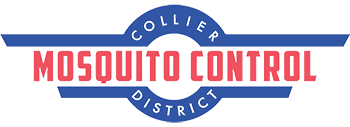COLLIER MOSQUITO CONTROL DISTRICT
District Map & Fact Sheet
The Collier Mosquito Control District serves 401 square miles in Collier County, protecting residents from mosquito-borne diseases and contributing to a high quality of life by controlling large populations of nuisance mosquitoes.
STAY INFORMED, STAY SAFE
The District Map
To confirm your property is within District borders, you may refer to your annual property tax bill. Properties within the District will have a line item indicated as Collier Mosquito Control under the Ad Valorem Taxes section.
District Boundaries
The District was founded in 1950 to treat 6 square miles with a mission of protecting public health from mosquito-borne disease. Today, we provide service to 401 square miles of Collier County — and contracted service to the Ave Maria community.
- Naples/Golden Gate/Estates/Marco Island – From the Lee County line south to Marco Island, including Goodland; and from the Gulf of Mexico to 11 miles east of Collier Blvd (CR 951).
- Immokalee area – From 2½ miles north of Main Street to 2½ miles south of Main Street; and 1 mile east of the Immokalee airport going west to Lake Trafford.
- The community of Ave Maria is under contract.
STAY INFORMED, STAY SAFE
Rules and Regulations
- Operate under Chapter 388, Florida Statutes
- Regulated by Florida Department of Agriculture and Consumer Services (DACS)
- Also comply with regulations established by the U.S. Environmental Protection Agency (EPA) and the Federal Aviation Administration (FAA)
STAY INFORMED, STAY SAFE
Custodian of Public Records
In compliance with §119.12(2), Florida Statutes, the contact information for the Collier Mosquito Control District’s custodian of public records, for purposes of public record requests pursuant to Florida’s public records laws, Chapter 119, Florida Statutes, is as follows:
Collier Mosquito Control District
Attn: Custodian of Public Records
600 North Road, Naples, Florida 34104
Phone: (239) 436-1000 Email: info@cmcd.org
STAY INFORMED, STAY SAFE
Funding 2022-2023
$18,657,777 – Local Taxes (Millage Rate – 0.1609)
$16,875,000 – Other (Contractual Treatment, Grants, Insurance Proceeds, Cash Carry-Over, Misc.)
$16,875,000 – Other (Contractual Treatment, Grants, Insurance Proceeds, Cash Carry-Over, Misc.)
$35,532,777 – Total
Why We Monitor and Treat
STAY INFORMED, STAY SAFE
The Two Most Important Reasons:
- Mosquito-borne diseases common to subtropical areas – West Nile virus, Dengue fever, Zika virus, Chikungunya virus, Eastern Equine Encephalitis, St. Louis Encephalitis, Malaria and dog heartworm
- Large numbers of nuisance biting adult mosquitoes – a major problem to SW Florida’s economy and residential comfort
STAY INFORMED, STAY SAFE
Mosquito Biology
- More than 50 species of mosquitoes in SW Florida
- Of those, the District closely monitors 5 species that can make humans and pets sick with diseases they carry
- The Southwest Florida environment promotes the growth of a mosquito from egg to adult in only 5-7 days

STAY INFORMED, STAY SAFE
Collecting Data
- The District monitors the community’s mosquitoes daily for population density, species identification, and presence of disease
- Data collection is the cornerstone of the District’s Integrated Mosquito Management (IMM) program
- A variety of traps (e.g., BG traps, CDC traps, etc.) collect mosquitoes for testing in our laboratory
- The mosquitoes are counted, separated by species, and tested for the presence of disease
- Landing rate count stations are located throughout the District — Field Technicians stand at the location for 2-5 minutes, counting the number of mosquitoes landing on them to collection additional data
STAY INFORMED, STAY SAFE
How does the District Control Mosquitoes?
Learn more about the Control Materials used by the District.
Controlling Mosquito Larvae
- Mosquito larvae are controlled by applying materials by truck, drone, or helicopter.
- Larval control methods we use: Bti liquid (16 oz./acre), Bti granular (4-7 lbs./acre)
Controlling Adult Mosquitoes
- Adult mosquitoes are controlled by applying materials by helicopter or airplane using Ultra Low Volume (ULV) technology. The ULV application releases material in droplets that are microscopic (i.e., about 20 microns). Little to no material makes it to the ground, and quickly dissipates – there is no residual effect.
- The ULV application is made from 300′ altitudes where the material treats the air space where mosquitoes are active using one of these chemicals — all at rates less than one ounce per acre: Dibrom (0.46 oz./acre), Duet HD pyrethroid (0.8/acre ), and organic Merus 3.0 pyrethroid (0.83 oz./acre)
STAY INFORMED, STAY SAFE
The Decision to Treat for Mosquitoes is Based Upon:
- Mosquito population numbers (larvae and adults)
- Mosquito species identification (larvae and adults)
- Compliance with material labels, rules and regulations
- Weather conditions
- Presence of disease in mosquito populations and health alerts (local, State and Federal)
- Mosquito population data, including citizen complaints by website and phone
Follow Us on Social Channels for the Latest News
Treatment updates, latest news, mosquito safety tips.


